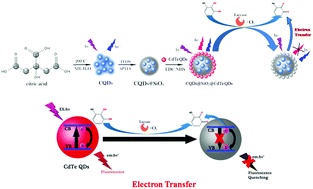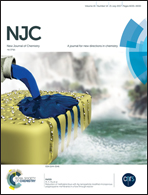Visual and fluorescence detection of pyrogallol based on a ratiometric fluorescence-enzyme system†
Abstract
In this study, we designed a ratiometric fluorescent probe that possesses a built-in correction and increases the probe accuracy. The surface of CdTe quantum dots (CdTe QDs) is modified with Glutathione (GSH) and these CdTe QDs are covalently conjugated to amino-functionalized silica-coated carbon dots (CQDs@SiO2) via carbodiimide chemistry. In the presence of laccase, pyrogallol (PG) is catalytically oxidized to a colored quinone compound that quenches the fluorescence of CdTe QDs through an electron transfer (ET) process. Therefore the ratiometric fluorescent probe (CQDs@SiO2@CdTe QDs) can be utilized for the sensitive and selective detection of PG when coupled with enzyme catalysis. Furthermore, a linear relationship was observed between the ratiometric fluorescence intensity and PG in the range of 0.05 to 2.0 μM with a detection limit of 0.042 μM. To verify this premise, the ratiometric probe was successfully applied to the determination of PG in tap water and river water using the standard addition method which yielded recoveries between 92.7% and 97.5%. The results revealed that the method has potential applications in the sensitive and selective determination of PG in real samples. Moreover, we further explored the ability of the method to detect ascorbic acid (AA). The established fluorescence sensing system also has potential to detect AA.



 Please wait while we load your content...
Please wait while we load your content...